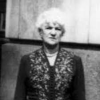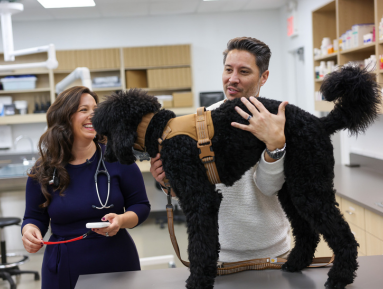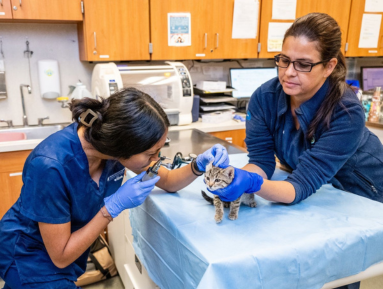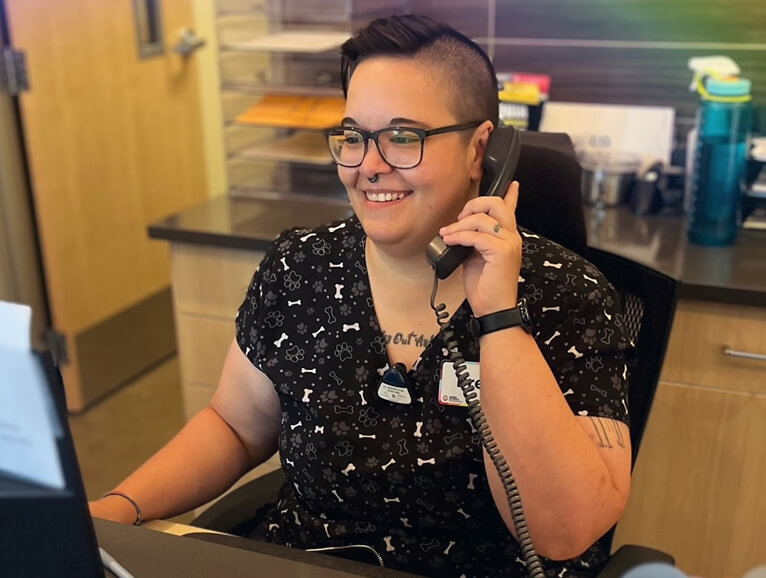
Female Veterinarians Who Changed Animal Medicine
Veterinary Medicine
Women's History
Meet 7 Female Veterinarians Who Changed Animal Medicine
As recently as 1975, women made up only 5% of the veterinary profession.1 By 2010, however, women made up roughly 50% of the profession; and today, approximately 67% of practicing veterinarians in the United States and 80% of American veterinary school students are women.2 Further, 77.3% of all veterinary technicians are women.3
This remarkable shift in the veterinary field did not happen by accident. Pioneering female veterinarians and scientists fought for their place in veterinary medicine, overcoming stereotypes and discrimination. In honor of Women’s History Month, and International Women’s Day on March 8, we are recognizing several inspiring women in honor of their contributions to science, medicine, politics and women’s professional achievements.
Dr. Elinor McGrath

Widely considered one of America’s first female veterinarians, Dr. Elinor McGrath was born in 1888 and became the first woman ever admitted to Chicago Veterinary College in 1907. She endured bullying and harassment from schoolmates, but persevered and graduated in 1910—a decade before U.S. women were granted the right to vote. Following graduation, Dr. McGrath ran a small animal practice in Chicago and became known for her animal-friendly practices. During her several decades as a practicing veterinarian, Dr. McGrath also established the city’s first pet cemetery, inspired by her understanding of the everlasting bond between people and their pets.
Dr. Patricia O’Connor Halloran
Dr. Patricia O’Connor Halloran was born in 1914 and grew up in Buffalo, NY. In 1939 she graduated from Cornell University College of Veterinary. After graduation she worked in private practice in Charleston West Virginia. Once she was married in 1940, she and her husband, Dr. John Lewis Halloran Jr both worked for his father’s private practice where her husband was paid, and she did not earn a salary.
In 1942 the Staten Island Zoo hired her to work as a temporary veterinarian due to a shortage of male doctors during the war. It was here that she became the first female zoo veterinarian. However, once the war ended, she remained as the chief animal caretaker where she worked until her zoo retirement in 1966. Following this she ran her husband’s small clinic where she also consulted for an experimental animal colony at the US public health on Staten Island. In 1999 she fully retired in Indiana.
Dr. Jane Hinton
When Dr. Jane Hinton graduated from the University of Pennsylvania in 1948, she became one of the first two African American women to earn the degree of Doctor of Veterinary Medicine. Prior to becoming a veterinarian, Dr. Hinton worked alongside her father—Harvard University’s first black professor—and invented a medium that would go on to be known as Mueller-Hinton agar which is still used to grow bacteria to test for resistance to antibiotics.
Dr. Alfreda Johnson Webb
Dr. Webb was the first Black American woman to earn a bachelor’s degree in veterinary medicine, and one of the first two Black American women to become a Doctor of Veterinary Medicine. She was also the first Black woman to hold a position in the North Carolina General Assembly.
She began her career as an instructor in anatomy at Tuskegee in 1950 and remained there until 1959 rising to the rank of associate professor. She then moved to Greensboro, North Carolina, and became a professor of biology at North Carolina Agricultural & Technical State University (NC A&T) from 1959 to 1978 and professor/coordinator of Laboratory Animal Science from 1977 until her retirement. Her research areas included histology, cytology, and embryology.
During her time at NC A&T in the late 1970s, Webb served on the planning committee for the school of veterinary medicine for North Carolina which was founded at North Carolina State University in 1981.
Dr. Aleen Cust
Aleen Cust trained to be a nurse, but later trained as a veterinary surgeon at what would later become the University of Edinburgh’s Veterinary School. Studying under a fake name to spare her family any embarrassment, Aleen finished at the top of her class with a degree in zoology. However, Aleen was banned from sitting for the Royal College of Veterinary Surgeons exams due to her gender. Unable to gain an official degree, Aleen's pursued work as a veterinary assistant and a bacteriologist with an equine unit during WWI. In 1919, when she came home from the war, she was finally allowed to take the RCVS exam thanks to the Sex Disqualification Removal Act that passed that same year. Aleen finally became Dr. Aleen Cust and the first woman to be recognized by the RCVS.
Dr. Phyllis Lose
By the time she was just nineteen, Phyllis Lose convinced racetrack stewards to allow her to test and certify to become the youngest racehorse trainer in the country. During this time, she was one of only three women horse trainers in the United States. She graduated from the University of Pennsylvania Veterinary School in 1957 and upon graduating, she worked the jobs that no other veterinarians would take such as working as the on-call vet for a local circus and treating dangerous horses. Eventually, she built a network of well-respected clients who helped her to create the first female-owned equine surgical practice. Dr. Lose served as the primary care veterinarian for the Philadelphia Mounted Police and Canine Unit, the track veterinarian for Philadelphia Park, and the first female member of the American Association of Equine Practitioners.
Dr. Aline Schunemann de Aluja
Dr. Aline Schunemann de Aluja has fought to improve conditions for animals in Mexico's slaughterhouses and animal markets since she was a veterinary student in the 1940s.
She had a special affection for animals, which led her to study veterinary medicine. After earning her veterinary degree at UNAM, Dr. Aluja joined most of Mexico's veterinarians in working to control foot-and-mouth disease.
She would briefly study at the University of Zurich and The Royal Veterinary College at the University of London, then return to UNAM's veterinary school and assist the professor in charge of the school's histology and pathology education. She again briefly left the university for further studies, earning a master's in pathology at the University of Pennsylvania in 1962. Returning to Mexico City, she helped modernize UNAM's pathology program, creating new collections of case studies and slides to teach gross pathology.
Dr. Aluja earned the title of emeritus professor in 1985. She received national awards for teaching and welfare in 1989 and 1993, respectively, and helped restructure the veterinary and animal production curriculums three times from 1974-2004. She has also provided expertise to the Food and Agriculture Organization of the United Nations in Africa, Asia, Europe, and South America.
You also may like
-

Life @ Petco
We’re here to improve the lives of pets, pet parents and each other by fostering a welcoming, respectful and safe workplace where everyone belongs.
-

Veterinary Careers Start Here
There's more than one way to practice high-quality medicine.
-

Relief Veterinarian Opportunities
Explore the various veterinary services and career opportunities available through Vetco, including Vetco Total Care Hospitals, Vetco Vaccination Clinics, and more.
Join our Talent Community
Get the latest on career news, opportunities, and events that match your background.


Returning Applicants
If your are a returning candidate with an existing account, please click below.

Current Petco Partners
Current Partners can explore internal opportunities by logging into Workday.